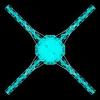Leaderboard
Popular Content
Showing content with the highest reputation on 01/12/15 in Posts
-
Building Drift in ETABS Drift is a very complex topic in structural engineering. It involves too many factors to arrive at a suitable decision. It involves engineering judgment, the phenomenon fresh engineers might not feel. In this article, I have tried to explain what is building drift, allowable limits, ways and means to check in ETABS models and to control the excessive drift. Please keep in mind, this article is not about the building drift as far as structural science is concerned, rather this topic of drift is related to ETABS software. First of all you must be familiar with the term story drift. For convenience, I am quoting here the definitions from UBC-97 code:- STORY DRIFT is the lateral displacement of one level relative to the level above or below. STORY DRIFT RATIO is the story drift divided by the story height. 1) Maximum Limits Now what for story drift limits? What is the maximum permissible value? Well it depends upon the type of drift. Is it seismic or wind? For seismic, I will refer to UBC-97 code which in section 1630.10.2 talks about drift limits for earthquake. Now in simple words, the maximum limit for seismic drift is:- delta M shall not exceed 0.025 x story ht (if building seismic period is less than 0.7) delta M shall not exceed 0.020 x story ht (if building seismic period is equal or greater than 0.7) Important to note here is that it talks about SEISMIC drift so SEISMIC building period not the WIND period. Now delta M = Max inelastic response displacement = 0.7R delta S where R = from Table 16-N delta S = displacement from static, elastic analysis this value is read from ETABS. you multiply this value by 0.7R to get delta M This was all about seismic drift, but for wind drift code is mute. I will refer you to ASCE 2005 commentary CC.1.2 So we can understand that the limit for wind drift is "on the order of l/600 to l/400" for "common usage". This is common thing, however, in reality this figure can be up or down depending upon the ductility of cladding material and finishes. However for common usage value of l/400 is thought to be well satisfactory. Here l means story ht. The concept of drift limits is same throughout all the governing codes, and the typical limits of story height by some number is same, but obviously you have to take care of the process of calculating the wind force or seismic forces. You should not calculate wind force from one code and apply limits of another code. 2) Load Combinations Once the drift limit has been determined separately for seismic and wind forces, now is the need to check the actual drift vs the limit. Determination of actual drift depends on the load combination and the period of recurrence. If not properly calculated, this may dramatically increase or decrease the accepted drift values in model. Seismic force E is always already factored so that's the reason its factor is always 1.0 in load combinations of ACI/ASCE code. The recurrence period for seismic force is 50 years. In seismic drift we do not convert it into service seismic force. Seismic drift is checked against the direct load case of EQx, EQy etc in ETABS. For wind drift, we need to convert 50 year wind to service wind force. It has been recommended by ASCE commentary CC.1.2 To convert 50 year service wind force to 10 year service wind force it is multiplied by 0.7, as the equation says, and other gravity loads; D and 0.5L are also added. So in a nutshell we create following load combinations in ETABS to check our drift:- DRIFTWx1 = D+0.5L+0.7Wx DRIFTWx2 = D+0.5L-0.7Wx DRIFTWy1 = D+0.5L+0.7Wy DRIFTWy2 = D+0.5L-0.7Wy For seismic drift, as discussed earlier, we do not need any combination, drift will be checked just on EQx and EQy load cases only. 3) How to check in ETABS Now we have obtained both the actual drift and the drift limit, but how can we do this in ETABS easily? Well, after creating the drift combinations as discussed in step 2, we need to do as below:- For seismic drift goto File>Print Tables>Summary Report Select the file name Scroll down to the end of the page, you will find out a section about drifts, similar to this one:- It displays the max drift for each lateral load case for each story. As we want the drift for wind to be on drift load combinations and not on wind load cases, so we will not compare this wind drift without limits. In this table we are going to check just the drift values of our ETABS model for individual seismic load cases; EQx and EQy. As you noticed, this table shows us values in fraction format. For example 1/105 that becomes 0.009523809524. This 1/105 value is story drift divided by story ht. It means delta S / story ht. Now this value is delta S. First we need to convert it to delta M by multiplying it with 0.7R. Assume R here is 3.5 so delta M = 0.7 x 3.5 x 1/105 = 7/300 = 0.023333 which is less than 0.025 so safe ( if T<0.7). So instead of calculating every time by 0.7R we can check these limits in other way. If our limit is 0.025 then the limit we get is 0.025/R/0.7. Assume R=3.5. Now the values in ETABS are inverse so our limit is 0.7x3.5/0.025 = 98. In ETABS the drift is reported as 1/x where x is some number. Now as long as x (some number) is greater than 98 our limit of 0.025 x story ht is being satisfied. This way you can quickly check and compare seismic drifts. Now for the wind drifts, goto Display>Show tables, select Point displacements>Story drifts and then select only drift combinations for results. Click on and then copy the table to EXCEL. To save time you can right click on EXCEL taskbar and select maximum and minimum. Then just select the column H or I and see the maximum value that should be less than H/400 to H600 limit (0.0025 t0 0.00167). Again the values reported in ETABS are divided by story ht. http://4.bp.blogspot.com/-9qv8XKHgL8Q/UALNKflmVsI/AAAAAAAAAEQ/AwKBYWt2iys/s320/image022-773193.jpg 4) Controlling Excessive Drift Values sometimes you may face problem of excessively large values in drift tables in ETABS. Well we are not going to talk about different measures and modeling techniques to control the drift values. We are going to talk about large numbers in drift tables. Sometimes it happens that a point or node is free in the model or is connected to a NULL line or very flexible section. Drift tables for example the story drift table in wind captures the maximum displaced points. Obviously the displacement of several meters in tables is not what we are looking for. Drift values (relative) may be still okay for these points, but it requires you to check the displacement values too before checking directly the drift. Unlock the model and remove all free points, check for any discontinuity and modify your models to remove all the errors.1 point
-

Sefp Consistent Design
Waqas Haider reacted to UmarMakhzumi for a topic
Salaam All, Looking forward to develop a series of articles under the title of "SEFP Consistent Design". The aim is to provide simple and lucid examples for our Pakistani Engineers that use UBC 97; examples will serve as quick reference and try to clarify misconceptions prevalent in design offices. Anyone, who would like to volunteer on this is most welcome. As the name indicates, "consistent design" is meant to spread common understanding of complex code clauses that a design engineer faces on a day to day basis. e.g., calculating story stiffness, or designing a flexible diaphragm. Examples would be pure, and written by authors with copyrights to SEFP. Current target is to have at least 2 examples published per month. I hope this will help young engineering to develop a rock-solid understanding and design the right thing rather than saying yes to whatever they are told to follow.That's my goal. Any ideas, input, volunteering in appreciated. Thanks.1 point -
.thumb.jpg.700916fbc7ead330085e15745d0270bd.jpg)
Development Length Of Standard Hooks
UmarMakhzumi reacted to Waqas Haider for a topic
Thank you very much bhai for you response.1 point -
1 point
-

Aci 12.10.1 Confusion
Waqas Haider reacted to UmarMakhzumi for a topic
1 point -

Development Length Of Standard Hooks
Waqas Haider reacted to UmarMakhzumi for a topic
Correct. I don't know if reserve strength is the right word but simply put it this way that we want plastic hinge formation in beams, which shall require full fy development thus no ld reduction. Thanks.1 point -

Sefp Consistent Design
Waqas Haider reacted to EngrUzair for a topic
Aoa, Sir Umar! Firstly, I totally agree with the idea of "Consistent Design", for the Pakistani Engineers. BTW, What is the progress achieved on this idea so far? Secondly, IMHO this idea of Consistent Design may be made even more useful, keeping in view following comments: 1. What I have understood from your post, your basic idea is limited to consistent design for UBC-97 and earthquake resistant design ONLY. IMO, this should extend to all other design types, based either on material (concrete, steel, wood etc) or the nature of loading (earthquake, wind, snow, etc) as well. 2. According to my knowledge, although in our country mostly US Design Codes are being used by private consultants or government departments, there is generally no consensus among the structural engineers as to which design codes (British or US) are to be adopted, even for common materials like concrete and steel. In this context, first of all we should decide a standard or 'Consistent' Structural Design Criteria for the proposed 'Consist Design'. This design criteria should include both 'Material design Codes' for the various structural materials (concrete, steel, wood etc) and the 'Loading Codes' (for dead, live, earthquake, wind, snow etc). My recommendations regarding 'Consistent Structural Design Criteria', are as follows: a. We should use US Material Design and Loading codes, being more advanced and progressive. And, also because our national building code, Building Code of Pakistan, is based on US codes. b. In line with above recommendation, specific Material Design codes should be: (1) ACI 318 for Reinforced Concrete Design (2) AISC 360 for Structural Steel Design (3) AISI for Cold-Formed Steel Design c. Specific Loading codes should be: (1) Building Code of Pakistan (Seismic Provisons-2007) and UBC-1997 for Earthquake (Seismic) Loads (2) ASCE 7 for all other (Dead, Live, Wind, Snow) Loads Thirdly, this is a very important and special topic. As such, it should be allotted a separate full forum, and all the relevant posts should be placed in this new forum. Thanks.1 point -

Sefp Consistent Design
Waqas Haider reacted to abdulqadeer29 for a topic
SIR, surely this will give a very much clear picture of things and make concept very much clear....the problems which i faced today surely everone face those at their initial stages, but sometime we are lucky to get a good senior in our office to guide us in the right way , but you are not lucky evertym , sometym you just have to follow the usual practice that is going on in your office without getting proper concept behind those things, and if there is something new we got and stuck in that, our seniors just simply say " you are doing wrong" without explaining the main reason behind.... sir i appreciate your Idea and i wish more experience people join you in this cause ..............1 point -
Insertion/cardinal Points
Osama Anwar reacted to WR1 for a topic
as a whole we dont go in tiny details like adjusting cardinal points....remember that there are 100 ways to pass a failed member but just dont do it..its not practical to adjust each and every beam and column by selecting appropriate cardinal points..just do center to center...struc analsyis is based on center to center..there are ways and means to be on the safer side.. I mean you should limit your interaction reatio for columns upto 0.8 not more than that instead of 0.99...So put more attention on the results rather being lost in model making perfection (like what i used to be in past )1 point
